Mollans-sur-Ouvèze
9 km from Buis les Baronnies via the D4 road.
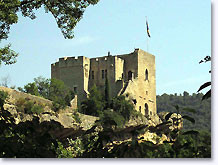
In the Middle Ages Mollans-sur-Ouvèze served as the “border” between the Comtat Venaissin and the Dauphiné region, i.e. the rich plain and the dry mountains.
It was a gateway that had to be guarded to guarantee peace within the Baronnies - and so it came to be known as the "Baronnies Gate".
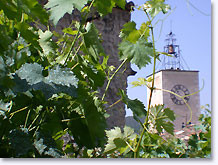
At that time this fortified village had two castles, three towers and a drawbridge, all protected by a ring of defensive walls.
Perched on their craggy rocks, the two feudal castles (one of which has been restored) still overlook the village.
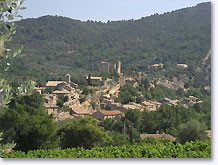
Today Mollans is a quiet market town in the plain of vineyards and fruit orchards on the banks of the Ouvèze river, where olive trees, lime trees and lavender are still cultivated by the local farmers.
It might not be obvious, but Mollans-sur-Ouvèze has many charming features you can discover on foot, starting for example in the lower village, where you should make your way to the bridge built in medieval times, with its single arch.
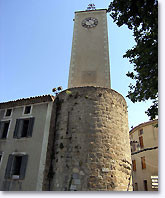
In olden times three round towers guarded this bridge, but only one is left today. It was used as the foundation for a belfrey in the early 18th century. It is known as the Clock tower and towers over a tiny round chapel built overhanging the bed of the Ouvèzee.
Baptisé “Tour de l’Horloge”, il domine une minuscule chapelle ronde bâtie en encorbellement au-dessus du lit de l’Ouvèze.
Cross the bridge and on the other side of the river you'll find a marvellous fountain, called the Dolphin's Fountain, and its roofed wash-house with seven arcades. The whole ensemble is listed, quite rightly.
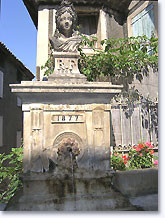
Now get ready to explore the upper village, a labyrinth of narrow alleys, lined with old houses and perched gardens. At the top stand the ruins of a fortress. All that is left is the base of the keep and some of its defensive structures.
It was built by the Counts of Mévouillon in the 12th century, and today is private property. Only from underneath is it possible to appreciate its simple design, square and squat combining a medieval part with a Renaissance part.
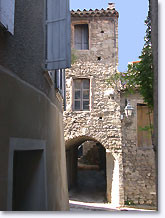
As you come back down from the castle, in the church of Saint-Marcel admire Carrare’s polychrome marble altar, designed in the baroque flamboyant style.
There is also a charming little square and its wash-house, and a house perched on a twin arcade stretching over the streets. It used to be the chapel of the Pénitents, and today houses the municipal archives.
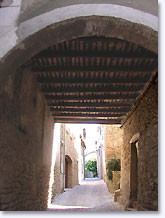
Mollans-sur-Ouvèze is well known for its many mill products (wheat and oil), its silk-worm farm (one of the oldest and largest in the area) and its many shops along the “Grande Rue”.
Gourmets are also attracted by the local speciality, the "Coco de Mollans", a white bean with a subtle taste, that goes down beautifully with a good local Côtes du Rhône. Good health!
What to see
The two feudal castles (upper fort and lower fort).
Fontaine aux Dauphins (1713) and roofed public wash-house (19th century), listed together as a Historical Monument.
Chapel of N.D. de la Compassion (1851) overhanging the river.
Medieval bridge.
Saint-Marcel church (Carrare’s polychrome marble altar inside, a beautiful example of the mid-18th century flamboyant baroque style).
Former chapel of the Pénitents (17th century).
Leisure activities
Pas du Ventoux activity park ( swimming pool, tennis, table-tennis, pétanque, mini-golf, basketball).
Hiking (to summits such as the Ventoux and the Luberon.
Walks in the olive groves or up to the passes of Milmandre and Malpertuis.
Mountain biking (waymarked routes starting from Buis-les-Baronnies).
Climbing (à Buis-les-Baronnies).
Air sports (take-off areas for hang-gliders and paragliders).
Clay pigeon shooting. 4WD. Quad.
Swimming (plenty of possibilities for river bathing).
Tennis.
“Les peintres dans la rue" (painters in the street – early July).
NEIGHBOURING TOWNS AND VILLAGES
Pierrelongue (3km), Puyméras (8km) and Buis-les-Baronnies (9km).

